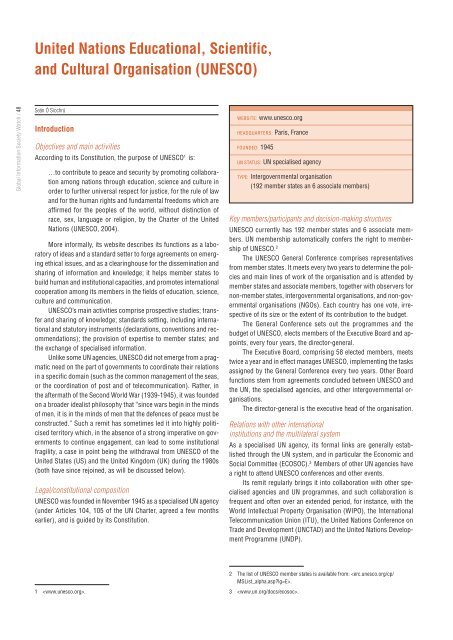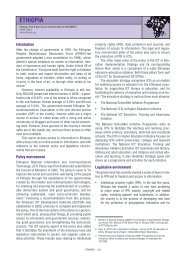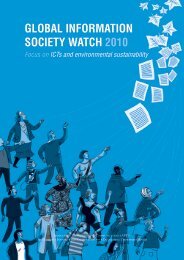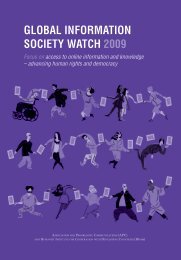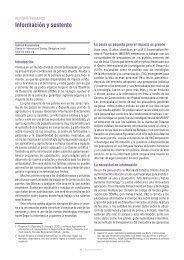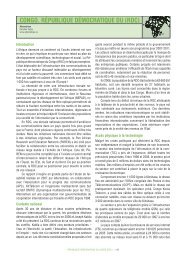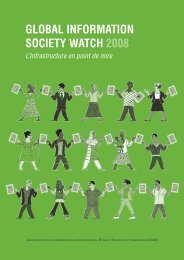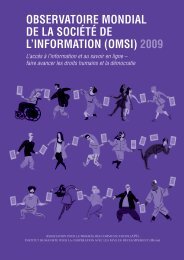UNESCO - Global Information Society Watch
UNESCO - Global Information Society Watch
UNESCO - Global Information Society Watch
You also want an ePaper? Increase the reach of your titles
YUMPU automatically turns print PDFs into web optimized ePapers that Google loves.
United Nations Educational, Scientific,<br />
and Cultural Organisation (<strong>UNESCO</strong>)<br />
<strong>Global</strong> <strong>Information</strong> <strong>Society</strong> <strong>Watch</strong> / 48<br />
Seán Ó Siochrú<br />
Introduction<br />
Objectives and main activities<br />
According to its Constitution, the purpose of <strong>UNESCO</strong> 1 is:<br />
…to contribute to peace and security by promoting collaboration<br />
among nations through education, science and culture in<br />
order to further universal respect for justice, for the rule of law<br />
and for the human rights and fundamental freedoms which are<br />
affirmed for the peoples of the world, without distinction of<br />
race, sex, language or religion, by the Charter of the United<br />
Nations (<strong>UNESCO</strong>, 2004).<br />
More informally, its website describes its functions as a laboratory<br />
of ideas and a standard setter to forge agreements on emerging<br />
ethical issues, and as a clearinghouse for the dissemination and<br />
sharing of information and knowledge; it helps member states to<br />
build human and institutional capacities, and promotes international<br />
cooperation among its members in the fields of education, science,<br />
culture and communication.<br />
<strong>UNESCO</strong>’s main activities comprise prospective studies; transfer<br />
and sharing of knowledge; standards setting, including international<br />
and statutory instruments (declarations, conventions and recommendations);<br />
the provision of expertise to member states; and<br />
the exchange of specialised information.<br />
Unlike some UN agencies, <strong>UNESCO</strong> did not emerge from a pragmatic<br />
need on the part of governments to coordinate their relations<br />
in a specific domain (such as the common management of the seas,<br />
or the coordination of post and of telecommunication). Rather, in<br />
the aftermath of the Second World War (1939-1945), it was founded<br />
on a broader idealist philosophy that “since wars begin in the minds<br />
of men, it is in the minds of men that the defences of peace must be<br />
constructed.” Such a remit has sometimes led it into highly politicised<br />
territory which, in the absence of a strong imperative on governments<br />
to continue engagement, can lead to some institutional<br />
fragility, a case in point being the withdrawal from <strong>UNESCO</strong> of the<br />
United States (US) and the United Kingdom (UK) during the 1980s<br />
(both have since rejoined, as will be discussed below).<br />
Legal/constitutional composition<br />
<strong>UNESCO</strong> was founded in November 1945 as a specialised UN agency<br />
(under Articles 104, 105 of the UN Charter, agreed a few months<br />
earlier), and is guided by its Constitution.<br />
WEBSITE: www.unesco.org<br />
HEADQUARTERS: Paris, France<br />
FOUNDED: 1945<br />
UN STATUS: UN specialised agency<br />
TYPE: Intergovernmental organisation<br />
(192 member states an 6 associate members)<br />
Key members/participants and decision-making structures<br />
<strong>UNESCO</strong> currently has 192 member states and 6 associate members.<br />
UN membership automatically confers the right to membership<br />
of <strong>UNESCO</strong>. 2<br />
The <strong>UNESCO</strong> General Conference comprises representatives<br />
from member states. It meets every two years to determine the policies<br />
and main lines of work of the organisation and is attended by<br />
member states and associate members, together with observers for<br />
non-member states, intergovernmental organisations, and non-governmental<br />
organisations (NGOs). Each country has one vote, irrespective<br />
of its size or the extent of its contribution to the budget.<br />
The General Conference sets out the programmes and the<br />
budget of <strong>UNESCO</strong>, elects members of the Executive Board and appoints,<br />
every four years, the director-general.<br />
The Executive Board, comprising 58 elected members, meets<br />
twice a year and in effect manages <strong>UNESCO</strong>, implementing the tasks<br />
assigned by the General Conference every two years. Other Board<br />
functions stem from agreements concluded between <strong>UNESCO</strong> and<br />
the UN, the specialised agencies, and other intergovernmental organisations.<br />
The director-general is the executive head of the organisation.<br />
Relations with other international<br />
institutions and the multilateral system<br />
As a specialised UN agency, its formal links are generally established<br />
through the UN system, and in particular the Economic and<br />
Social Committee (ECOSOC). 3 Members of other UN agencies have<br />
a right to attend <strong>UNESCO</strong> conferences and other events.<br />
Its remit regularly brings it into collaboration with other specialised<br />
agencies and UN programmes, and such collaboration is<br />
frequent and often over an extended period, for instance, with the<br />
World Intellectual Property Organisation (WIPO), the International<br />
Telecommunication Union (ITU), the United Nations Conference on<br />
Trade and Development (UNCTAD) and the United Nations Development<br />
Programme (UNDP).<br />
1 .<br />
2 The list of <strong>UNESCO</strong> member states is available from: .<br />
3 .
Commitment to development<br />
The <strong>UNESCO</strong> Constitution and later legal instruments do not specifically<br />
refer to a commitment to development, and indeed development<br />
per se is not among its key goals. However, many of its declarations,<br />
conventions and recommendations do have implicit and explicit developmental<br />
components, and developing countries are often singled<br />
out for special support.<br />
Its programmes prioritise least-developed countries (LDCs) and<br />
poverty reduction. The Medium-Term Strategy for 2002-2007 includes<br />
a cross-cutting theme on “Eradication of poverty, especially extreme<br />
poverty”, and a specific commitment to prioritise LDCs across all its<br />
programmes (<strong>UNESCO</strong>, 2002a).<br />
Programme V on Communication and <strong>Information</strong>, for instance,<br />
gives priority attention to the needs of LDCs and Africa “in such areas<br />
as capacity-building, ICT applications in community development including<br />
water management and ICT literacy, to sustain <strong>UNESCO</strong>’s<br />
contribution to NEPAD [New Partnership for Africa’s Development]”<br />
(<strong>UNESCO</strong>, 2006a).<br />
<strong>UNESCO</strong> also frequently facilitates the participation of actors from<br />
developing countries in its meetings and events, by supporting travel<br />
and subsistence and by organising global and regional events in developing<br />
countries.<br />
Commitment to gender equality<br />
Similarly, <strong>UNESCO</strong> does not have a core legal instrument regarding<br />
gender equality, but its gender mainstreaming policy is defined in the<br />
organisation’s Medium-Term Strategy for 2002-2007. In addition,<br />
<strong>UNESCO</strong>’s Gender Mainstreaming Implementation Framework (GMIF)<br />
for 2002-2007 offers guidelines on how to implement the policy commitment<br />
(<strong>UNESCO</strong>, 2002b).<br />
The framework was developed by the Section for Women and<br />
Gender Equality, with a staff of four and linked to designated gender<br />
focal points in Paris and field offices. Its goal is the overall integration<br />
of gender equality issues within <strong>UNESCO</strong>’s programmes, and it also<br />
maintains a Mainstreaming Resource Centre directed towards supporting<br />
policy-makers in this area.<br />
Within the Communication and <strong>Information</strong> Programme, gender<br />
concerns have been mainstreamed with special emphasis on “training,<br />
improving community access to information, knowledge and skills<br />
and increasing the capacity of professionals to produce and disseminate<br />
development messages” (<strong>UNESCO</strong>, 2006a).<br />
Southern actors and civil society participation<br />
The <strong>UNESCO</strong> Constitution defines the basis for cooperation with NGOs.<br />
<strong>UNESCO</strong> “may make suitable arrangements for consultation and cooperation<br />
with non-governmental organisations concerned with matters<br />
within its competence, and may invite them to undertake specific<br />
tasks. Such cooperation may also include appropriate participation<br />
by representatives of such organisations on advisory committees set<br />
up by the General Conference” (<strong>UNESCO</strong>, 2004, Article 11, para. 4).<br />
Over the years, <strong>UNESCO</strong> has developed (and occasionally reviewed<br />
and amended) an elaborate system of NGO participation<br />
– some say at times too elaborate – and General Conference Directives<br />
of 1995 and 2001 govern the current situation. Relations can be<br />
of two kinds, formal or operational, depending on the role and structure<br />
of the NGO concerned and their record on cooperation.<br />
At present <strong>UNESCO</strong> maintains official relations with 337 international<br />
NGOs and 26 foundations. Of these, about 15% are based in<br />
developing countries, just a handful in the least developed. Although<br />
many are international associations with members globally, it is still a<br />
small proportion.<br />
A feature unique to <strong>UNESCO</strong> is the <strong>UNESCO</strong> Clubs and Associations<br />
established at the national level to informally engage a wide range<br />
of actors on <strong>UNESCO</strong> issues; these actors may also participate in<br />
<strong>UNESCO</strong> as NGOs. There are now 4,000 associations, centres and<br />
clubs in about 100 countries, and at the international level, a World<br />
Federation of <strong>UNESCO</strong> Clubs, Centres and Associations (WFUCA). 4<br />
Official <strong>UNESCO</strong> Commissions also exist in all 192 member states<br />
and can act as a means to extend outreach into civil society at the<br />
national level. These are governed under a specific charter approved<br />
by the General Conference in 1978, and their function is “to involve in<br />
<strong>UNESCO</strong>’s activities the various ministerial departments, agencies,<br />
institutions, organisations and individuals working for the advancement<br />
of education, science, culture and information” (<strong>UNESCO</strong>,<br />
2002c).<br />
With regard to participation of Southern actors, <strong>UNESCO</strong>, as<br />
noted, has no specific structural features but has a stated commitment<br />
to support such actors and builds in participation through a<br />
variety of modalities.<br />
Role and responsibilities in ICTs<br />
Legal and constitutional basis<br />
Communication is the central instrument by which <strong>UNESCO</strong> achieves<br />
its mission. Article 1 of the Constitution states that to realise this<br />
purpose the organisation will “(a) Collaborate in the work of advancing<br />
the mutual knowledge and understanding of peoples, through all<br />
means of mass communication and to that end recommend such international<br />
agreements as may be necessary to promote the free flow<br />
of ideas by word and image.”<br />
ICT-related activities<br />
Given such a general remit, it is not surprising that <strong>UNESCO</strong> has been<br />
involved – and occasionally embroiled – in information and communications<br />
technology (ICT) and media issues throughout its evolution.<br />
From the late 1960s, satellite broadcasting across borders was a<br />
key political issue, and <strong>UNESCO</strong> responded in 1972 with the adoption<br />
of the Declaration of Guiding Principles on the Use of Satellite Broadcasting<br />
for the Free Flow of <strong>Information</strong>, the Spread of Education and<br />
Greater Cultural Exchange (<strong>UNESCO</strong>, 1972). Although promoting the<br />
principle of free flow, it also affirmed the principle of national prior<br />
4 More information available from: .<br />
Institutional overviews / 49
<strong>Global</strong> <strong>Information</strong> <strong>Society</strong> <strong>Watch</strong> / 50<br />
consent. As a declaration it was not binding, but the list of seven<br />
countries opposing it – they included the UK, the US, Australia, Germany<br />
and Canada – suggests that a cold war fracture was already<br />
opening. In 1974, along with WIPO, <strong>UNESCO</strong> oversaw a further convention<br />
on satellites, the purpose of which was to protect copyright<br />
owners of broadcast signals; the Convention Relating to the Distribution<br />
of Programme-Carrying Signals Transmitted by Satellite came<br />
into force in 1979. To some extent the contrast between these instruments<br />
is indicative of a shift in concerns away from balancing sovereignty<br />
against free flow, towards an emphasis on property rights, a<br />
move that was part of a wider global dynamic.<br />
However, international differences in these instruments were<br />
merely a prelude to <strong>UNESCO</strong>’s involvement in the New World <strong>Information</strong><br />
and Communication Order (NWICO) debate. This debate, initiated<br />
in the mid-1970s and led initially by the Non-Aligned Movement,<br />
5 focused on the impact of Northern-dominated media on development,<br />
though many other issues were involved at different stages.<br />
<strong>UNESCO</strong> took it up in 1976, and in 1978 the General Conference agreed<br />
a Declaration of Fundamental Principles concerning the Contribution<br />
of the Mass Media to Strengthening Peace and International Understanding,<br />
to the Promotion of Human Rights and to Countering Racialism,<br />
Apartheid and Incitement to War.<br />
Despite this agreement, major divisions soon emerged and an<br />
independent commission was established to come forward with recommendations.<br />
The result was a report called Many Voices, One World,<br />
presented to the General Conference in 1980 (MacBride et al. 1980).<br />
It considered media and communication in the widest sense and put<br />
forward a series of proposals. Unfortunately, the debate became embroiled<br />
in cold war politics, and distorted by commercial and political<br />
media interests, descending rapidly into fractious argument. Largely<br />
as a result, the US pulled out of <strong>UNESCO</strong> in 1984, followed by the UK,<br />
its strongest ally, the following year. Although NWICO continued on<br />
the <strong>UNESCO</strong> agenda for some time, it was finally replaced, following<br />
a vigorous debate at the 1989 General Conference, by the New Communication<br />
Strategy. Neither <strong>UNESCO</strong> nor any other UN institution<br />
has since hosted such a wide-ranging debate on media and communication.<br />
In 1990, as a result of an internal restructuring exercise, <strong>UNESCO</strong>’s<br />
Communication and <strong>Information</strong> Sector (CI) was established, consisting<br />
of the Communications Development Division, the Division for<br />
Freedom of Expression, Democracy and Peace, and the <strong>Information</strong><br />
<strong>Society</strong> Division.<br />
The CI provides the secretariat for two intergovernmental programmes:<br />
the International Programme for the Development of Communication<br />
(IPDC) and the <strong>Information</strong> for All Programme (IFAP).<br />
The IPDC, established in 1980, was seen by many as a pragmatic<br />
alternative to NWICO. In its first 25 years, it has dispensed USD<br />
92 million to more than 1,100 media development projects, granting<br />
just over USD 3 million to 120 national and regional projects globally<br />
in the year 2004/2005. The IFAP was established in 2001 as a platform<br />
for debate and action to help reduce the “digital divide” and to<br />
promote universal access. It has so far generated almost USD 2 million<br />
in funds, and approved 24 projects during 2005.<br />
Each programme has a board consisting of a number of member<br />
states (39 for IPDC and 26 for IFAP), elected by the General Conference.<br />
Operationally, the CI implements a set of actions that include funding<br />
Chairs in Informatics, supporting electronic educational networks,<br />
digitising public domain information, training in ICTs, offering advice on<br />
developing information policies, and running, with the ITU, Regional<br />
Symposiums on Telematics for Development. Some actions are undertaken<br />
in conjunction with other entities, such as the ITU and UNDP,<br />
where their remit overlaps. One example is the May 1995 study published<br />
jointly with the ITU, The Right to Communicate: At What Price?<br />
(<strong>UNESCO</strong>, 1995), which considered the economic constraints on the<br />
effective use of telecommunication in education, science and culture.<br />
The Community Multimedia Centre (CMC) programme is among<br />
the CI flagships. Up to 90 centres have now been supported in Africa,<br />
Latin America and the Caribbean and South Asia, as the programme<br />
continues to expand elsewhere. Each centre provides rural and remote<br />
communities with radio, internet and other ICT facilities for<br />
knowledge sharing and development.<br />
Other recent <strong>UNESCO</strong> intergovernmental actions are of at least<br />
tangential relevance. In October 2003, the General Conference approved<br />
the Recommendation concerning the Promotion and Use of<br />
Multilingualism and Universal Access to Cyberspace, 6 covering issues<br />
such as universal access to the internet, copyright and the public<br />
domain, and the balance between the interests of rights-holders<br />
and of the public. A recommendation, however, is not binding, and<br />
the language used is relatively weak.<br />
The Convention on the Protection and Promotion of the Diversity<br />
of Cultural Expressions was approved by the General Conference<br />
in October 2005. It was in part promoted as a means to ensure that<br />
cultural expressions, including audio and visual materials, could be<br />
fully defended in the context of trade agreements, such as those agreed<br />
in the World Trade Organisation (WTO), which many believe are undermining<br />
their cultural value in the interests of trade and commercial<br />
gain. The Convention was opposed primarily by the US.<br />
<strong>UNESCO</strong> and the WSIS<br />
The legal basis for <strong>UNESCO</strong> participation in the World Summit on the<br />
<strong>Information</strong> <strong>Society</strong> (WSIS) was never in doubt, given the strong remit<br />
in its Constitution and the existence of an <strong>Information</strong> <strong>Society</strong><br />
Division in the CI Sector.<br />
It is worth recalling that some time before the ITU announced in<br />
1998 its intention to organise the WSIS, <strong>UNESCO</strong> had been developing<br />
its own plans for a summit. In August 1996, instigated by the<br />
director-general, the <strong>UNESCO</strong> Executive Board began planning a Conference<br />
on <strong>Information</strong> and Communication for Development, to be<br />
5 The Non-Aligned Movement (NAM) is an international organisation of states<br />
– over 100 – not formally aligned with or against any power bloc.<br />
6 Available from: .
held in 1998, the goal of which was to “focus on development issues to<br />
which information and communication can make a meaningful contribution<br />
and (…) provide a forum for all who wish to contribute to the<br />
search for international consensus in these matters” (<strong>UNESCO</strong>, 1996a).<br />
In November the Executive Board agreed that “The possibility of<br />
co-organising the conference jointly with other bodies within the UN<br />
system, such as ITU, would be actively explored” (<strong>UNESCO</strong>, 1996b).<br />
Why <strong>UNESCO</strong> dropped the idea of the conference has never been<br />
publicly explained, although some within <strong>UNESCO</strong> view it as the origin<br />
of the idea of an intergovernmental event on the information society.<br />
The internal consideration by <strong>UNESCO</strong> of such a conference enabled a<br />
rapid and coherent response to the ITU initiative, and <strong>UNESCO</strong> was thus<br />
a very early and active contributor to the WSIS preparatory process.<br />
From the beginning, <strong>UNESCO</strong>’s goal was to broaden the agenda<br />
of the WSIS, and to extend civil society participation. Although not<br />
officially acknowledged, some in <strong>UNESCO</strong> shared the view of early<br />
civil society participants that the ITU’s understanding of the information<br />
society overemphasised infrastructure and technical aspects. Furthermore,<br />
the ITU’s unique structure, which encourages active participation<br />
from the private sector but refuses (in contravention of<br />
ECOSOC agreements) to officially recognise NGOs, left it ill equipped<br />
to negotiate the participation of civil society. 7<br />
The early stages of a summit routinely involve a process of<br />
agenda-definition as the lead agency, in this case the ITU, brings in<br />
and opens a dialogue with additional UN actors. <strong>UNESCO</strong>’s efforts in<br />
this regard focused on delivering a consistent message in all its activities<br />
under the theme “Towards Knowledge Societies” and four underlying<br />
principles: freedom of expression, universal access to information<br />
and knowledge, promotion of cultural diversity, and equal access<br />
to quality education. In general the intention was to concentrate<br />
on content and human-capacity issues associated with an information<br />
society, and this was evident in almost all its actions. Furthermore,<br />
<strong>UNESCO</strong>, unlike for instance the UNDP, took the opportunity of<br />
the WSIS to reinforce its ICT programmes.<br />
In relation to supporting civil society, <strong>UNESCO</strong> participated actively<br />
in the first civil society event relating to the WSIS, held in November<br />
2001 in Geneva, jointly organised by the Platform for Communication<br />
Rights and Friedrich Ebert Stiftung. <strong>UNESCO</strong>’S participation<br />
in this seminar – entitled “Communication as a Human Right in<br />
the <strong>Information</strong> <strong>Society</strong>: Issues for the World Summit on the <strong>Information</strong><br />
<strong>Society</strong>” – signalled its support for a broad and participatory<br />
approach to the Summit.<br />
Soon after, <strong>UNESCO</strong> organised a round of consultations with NGOs<br />
on the WSIS. The consultations were held in Paris over four separate<br />
days in February 2002. Although the lack of funding for travel and<br />
subsistence resulted in little participation from the South, the event<br />
facilitated the process of civil society coalescing around the WSIS.<br />
This was followed up in April with a two-day consultation, this time<br />
offering some support for Southern participation in an event that offered<br />
a platform for civil society to further develop their ideas. The<br />
outcomes, in terms of both proposed modalities of civil society participation<br />
in the WSIS and the substantive issues to be included, had a<br />
significant influence on civil society activities overall during the early<br />
WSIS phase and formed the point of departure for discussions at the<br />
first meeting of the Preparatory Committee (PrepCom) in July that year.<br />
<strong>UNESCO</strong> went on to support an online discussion forum for civil society<br />
from December 2002 until January 2003, although participation in<br />
this case was relatively limited. By then, in any case, civil society was<br />
well into the process of organising itself into various caucuses and<br />
others groups, and was developing its own communication structures.<br />
More generally, <strong>UNESCO</strong> took considerable pains to redirect and<br />
refocus its programme activities to fit into the WSIS and its “Knowledge<br />
Societies” agenda, especially through the design and refinement<br />
of the CI component of the 2002-2007 Medium-Term Strategy. 8 Some<br />
required little more than relabelling of existing activities; others were<br />
entirely new.<br />
In the first WSIS preparatory phase, <strong>UNESCO</strong> published a series<br />
of reports on different aspects of the information society; hosted a<br />
Ministerial Round Table Meeting alongside its October 2003 General<br />
Conference from which a communiqué, Towards Knowledge Societies,<br />
was issued; organised a High-Level Symposium on the eve of<br />
the Geneva Summit meeting in December 2003 that brought together<br />
40 ministers, most from the South; and sponsored seven side-events<br />
at the Geneva Summit itself. 9<br />
During the second phase, significant <strong>UNESCO</strong> activities included<br />
a series of thematic meetings in 2005, including two in Paris, one in<br />
Mali and one in Russia; the publication of Towards Knowledge Societies:<br />
<strong>UNESCO</strong> World Report, also in 2005 (<strong>UNESCO</strong>, 2005); and a<br />
further set of events at the Tunis Summit.<br />
Description and analysis of ICT activities<br />
<strong>UNESCO</strong> actions since the Tunis Summit<br />
<strong>UNESCO</strong>’s new Medium-Term Strategy for the years 2007 to 2013 is<br />
currently in advanced draft form, to be approved at the next General<br />
Conference. Programme V on <strong>Information</strong> and Communication has,<br />
according to senior staff, been structured to a very significant degree<br />
around those areas of the WSIS Action Plan for which <strong>UNESCO</strong> is the<br />
focal point.<br />
Action lines<br />
Under the Tunis Agenda and the subsequent consultation on Action<br />
Plan moderators/ facilitators held on 24 February 2006, <strong>UNESCO</strong> was<br />
assigned the role of interim focal point for four of the eleven full action<br />
lines contained in the WSIS Plan of Action, along with two of the<br />
eight ICT application areas grouped under action line C7. No other<br />
agency was given such a numerically prominent role in relation to the<br />
Institutional overviews / 51<br />
7 For documentation on an attempt to force ITU to open up to NGOs see:<br />
.<br />
8 For a complete list see: .<br />
9 More information is available from: .
<strong>Global</strong> <strong>Information</strong> <strong>Society</strong> <strong>Watch</strong> / 52<br />
action lines, underscoring again the extent to which the WSIS agenda<br />
overlapped with that of <strong>UNESCO</strong>. These action lines are:<br />
C3: Access to information and knowledge<br />
C7: ICT applications (two areas: e-learning and e-science)<br />
C8: Cultural diversity and identity, linguistic diversity and local<br />
content<br />
C9: Media<br />
C10: Ethical dimensions of the information society<br />
Initial meetings were held during 2006 in all of these areas, beginning<br />
with C8 on 12 May in Geneva; then C3, C10, C7 (e-learning)<br />
and C9 in Paris on four consecutive days beginning on 16 October;<br />
and finally C7 (e-science) on 22 October in Beijing, alongside a major<br />
science and technology conference taking place there.<br />
The purpose of the meetings was to constitute multi-stakeholder<br />
teams to move forward with each of the action lines, including designating<br />
a facilitator and sub-group moderators, devising terms of reference,<br />
and deciding on the activities to be pursued. No specific resources<br />
were available from <strong>UNESCO</strong> or other parties to facilitate the<br />
working of the team, and the facilitator is explicitly expected to be<br />
able to provide sufficient resources to cover the costs of his/her own<br />
activities. In all cases, <strong>UNESCO</strong> was confirmed by acclamation in its<br />
role as focal point for the specified action lines.<br />
The WSIS action lines vary greatly in terms of their breadth of<br />
scope and the precision of their focus. They also differ in the extent to<br />
which the elements of the Action Plan are already underway and contained<br />
in the plans of <strong>UNESCO</strong> and other organisations. These factors<br />
were reflected in the meetings, as they will be in any eventual outcomes.<br />
C3: Access to knowledge, for instance, is a key area with ten<br />
distinct actions, most of which are quite precise and well within the<br />
domain of <strong>UNESCO</strong> and other collaborating entities. Actions include:<br />
a) Develop policy guidelines for the development and promotion of<br />
public domain information and h) Support the creation and development<br />
of a digital public library and archive services.<br />
C9: Media, on the other hand, includes seven actions, most of<br />
which are quite vague and/or general, such as a) Encourage the media<br />
to continue to play an important role in the information society<br />
and c) Take appropriate measures – consistent with freedom of expression<br />
– to combat illegal and harmful content in media content.<br />
Similarly, C10: Ethical dimensions has four actions including a) Take<br />
steps to promote respect for peace and to uphold the fundamental<br />
values of freedom, equality, solidarity, tolerance, shared responsibility,<br />
and respect for nature and b) All stakeholders should increase<br />
their awareness of the ethical dimension of their use of ICTs. And C8:<br />
Cultural diversity has a total of fifteen disparate actions covering hugely<br />
different areas and qualitatively different in nature.<br />
Indeed, most of the actions within each area are disconnected,<br />
and often the implicit comprehension of the domains covered does<br />
not reflect actual good practice on the ground.<br />
Thus <strong>UNESCO</strong> and the multi-stakeholder teams face a significant<br />
challenge in developing coherent sub-groups and focused actions.<br />
Meetings took different approaches. Some action lines broke<br />
into sub-groups to develop more specific activities; others stayed in<br />
plenary. Plenary discussion often opened out into general issues, and<br />
lists of desirable actions, before being pulled in by the chair. For the<br />
most part, they were conducted in a traditional and formal manner<br />
with tight chairing and facilitation and considerable discretionary power<br />
in the hands of the chair to continue or discontinue a subject and to<br />
wrap up with a specific conclusion.<br />
Each of the action lines did establish multi-stakeholder teams to<br />
carry them forward, some with quite specific goals, though few if any<br />
at this point comprise all key actors necessary to push forward their<br />
domain of work. Civil society participation overall was relatively weak<br />
as compared to the level seen during the WSIS itself, and the number<br />
of participants from the South was limited, though they were vocal in<br />
most meetings. The absence of specific funding to defray the cost of<br />
participation may have contributed to the low numbers overall, especially<br />
of civil society and Southern representatives, but with a few<br />
exceptions the level of enthusiasm was muted and it proved difficult<br />
to establish an energetic consensus on moving forward.<br />
<strong>UNESCO</strong> is organising an online platform for ongoing discussion,<br />
and collaboration is also being organised to facilitate further<br />
team development.<br />
Prospects for implementation<br />
<strong>UNESCO</strong>, in common with all participating organisations, faces a difficult<br />
task in implementing these action lines. Some obstacles, such<br />
as lack of precision and a very general focus, may be overcome through<br />
concerted effort on the part of the multi-stakeholder teams. Others,<br />
however, pose more serious challenges.<br />
Almost all action areas are already the subject of considerable<br />
activity, unrelated to the WSIS, among academics, NGOs, the private<br />
sector, intergovernmental bodies, national bodies and so forth, many<br />
of whom would be almost entirely unaware of the WSIS. Given the<br />
lack of new resources, the multi-stakeholder teams are not in a position<br />
to influence their respective domains through the launch of major<br />
new actions. And there already exist several bodies through which<br />
actors cooperate and form partnerships, coordinate their activities,<br />
exchange experiences, and so forth, such as the <strong>Global</strong> Knowledge<br />
Partnership (GKP), the <strong>Global</strong> Alliance for ICT and Development<br />
(GAID), and indeed the intergovernmental agencies themselves. How<br />
can relatively small numbers of somewhat disparate multi-stakeholder<br />
teams hope to bring some value-added to this field? What can they<br />
offer that will make a difference?<br />
The immediate outcomes of these meetings suggest that such<br />
an impact may be possible, but only in relatively few and quite specific<br />
areas, in which key organisations and entities already have a<br />
considerable stake, in which niche needs are not currently being addressed,<br />
and in which genuine collaborations can be nurtured with<br />
clear goals and outcomes.<br />
Such actions might be found under action lines 3, 7 and 8, and<br />
probably less so under action lines 9 and 10. However, any positive<br />
outcomes will depend largely on how actively and creatively the
multi-stakeholder teams approach the task, and the resources they<br />
can mobilise.<br />
The potential scale of outcomes, at least in these action lines,<br />
emerging from a global process of several years’ duration that consumed<br />
an enormous amount of time and funds, seems modest in the<br />
extreme. Some in <strong>UNESCO</strong> believe that much of the WSIS’ impact<br />
may be generated by less explicit and visible means, through the extensive<br />
networking that took place and will be reinforced on the ground,<br />
regionally, nationally and even locally. However, it is difficult to produce<br />
evidence of this, especially given that there are already so many<br />
other networking activities. Evidence is also scarce, at a higher level,<br />
of a development impact of the WSIS through integration into the<br />
wider development context, since the participation of core development<br />
actors – such as the relevant government ministries, key donor<br />
organisations and NGOs – in the overall WSIS preparatory process,<br />
Summits and follow-up was, and remains, limited.<br />
Other activities relating to the WSIS<br />
<strong>UNESCO</strong> is a member of the UN Group on the <strong>Information</strong> <strong>Society</strong><br />
(UNGIS) established by the UN secretary-general. It is set up as a<br />
mechanism to coordinate interagency implementation and to link the<br />
WSIS to other development modalities such as the Millennium Development<br />
Goals. Its first meeting was held in Geneva on 14 July 2006,<br />
chaired by the ITU secretary-general. <strong>UNESCO</strong> is one of three vicechairs,<br />
and will take the chair from July 2007, followed by the UNDP. 10<br />
<strong>UNESCO</strong> also participates in the work of the Internet Governance<br />
Forum, advocating an open, transparent and inclusive approach<br />
to the issue. Specific topics of interest include ethical dimensions,<br />
multilingualism on the internet and capacity building.<br />
Finally, <strong>UNESCO</strong> continues with its work with the Partnership for<br />
the Measuring of ICT for Development, focusing on indicators relating<br />
to its core concerns.<br />
Other ICT-related activities<br />
<strong>UNESCO</strong> has attempted, in the latter years of its 2001-2007 Medium-<br />
Term Strategy and in the entirety of its forthcoming Strategy, to bring<br />
its ICT-related activities within the general outcomes of the WSIS.<br />
However, several major programmes began before the first Summit,<br />
and are continuing thereafter. Recent developments in the most important<br />
of these are considered here.<br />
Both the <strong>Information</strong> for All Programme (IFAP) and the International<br />
Programme for the Development of Communication (IPDC) have<br />
recently been through evaluation processes. The former is not yet<br />
completed but the outcome may bring it closer to the WSIS implementation<br />
activities.<br />
IFAP at present faces a number of challenges, among them that it<br />
has very limited ongoing funding, its focus is not altogether clear, and<br />
there are questions concerning the strategic value of funding modest<br />
and relatively isolated projects. The evaluation, to be completed in early<br />
10 For more information see: and<br />
.<br />
2007, considers whether the focus should be placed more firmly on<br />
policy-related actions, marking a clear distinction from IPDC’s strong<br />
project focus.<br />
The structure of IFAP as a UN commission offers some possibilities,<br />
since it has a mandate to form national committees. The IFAP<br />
Bureau secretary also holds the post of <strong>Information</strong> <strong>Society</strong> director<br />
within CI; and the IFAP Council advises <strong>UNESCO</strong> on information society<br />
issues. Thus one option under consideration is to reposition IFAP<br />
as the coordinating vehicle for implementing <strong>UNESCO</strong>’s role in the<br />
WSIS. The national committees could play a key role in convening<br />
national actors and multi-stakeholder teams under the action lines,<br />
while at the institutional level, the Bureau could play a horizontal coordinating<br />
role while bringing together government and international<br />
non-governmental actors.<br />
Indeed, its mandate lends itself so well to a coordinating role in<br />
the information society that some see the failure to propose IFAP as<br />
the follow-up mechanism for WSIS, a role that was given to the Commission<br />
on Science and Technology for Development, as an opportunity<br />
lost.<br />
In the case of IPDC, reforms initiated in 2002 included a higher<br />
priority for projects promoting press freedom and media pluralism,<br />
community media, professional capacity and partnerships; the IPDC<br />
Council will now meet bi-annually instead of annually; the Bureau fully<br />
takes over selecting and financing projects; and field office advisers<br />
will assume greater responsibilities. The evaluators (Ronning and<br />
Orgeret, 2006, p. 8) concluded that “significant and impressive changes<br />
have taken place within IPDC since the [earlier] 2002 evaluation.”<br />
The Community Multimedia Centre (CMC) programme, a major<br />
programme of <strong>UNESCO</strong>’s Communication and <strong>Information</strong> Sector (CI),<br />
has also recently been evaluated. Launched five years ago, it is moving<br />
towards a second phase with a scale-up in some countries, and<br />
mainstreamed support. Generally, the evaluation is positive: “The CMCs<br />
are accepted by and fully integrated into the communities and can in<br />
many cases be sustained beyond the pilot phase without core operating<br />
grants... Longer term benefits are already being realised within individual<br />
communities, such as the gradual removal of barriers to social<br />
inclusion, the stimulation of poverty alleviation through access to knowledge<br />
of better health, resource management and agriculture practices,<br />
through the establishment of listeners clubs as self help groups... and<br />
the creation of new livelihoods opportunities” (<strong>UNESCO</strong>, 2006b).<br />
Shortcomings were identified, among them: Strong and consistent<br />
field support from <strong>UNESCO</strong> regional offices for the initiative, with<br />
one exception, is missing; efforts to achieve financial sustainability<br />
may be forcing CMC managers to target services at those who can<br />
pay, limiting access for the poor; there is a heavy reliance on volunteers;<br />
and the strategic timeframe for the initiative is unclear, as are<br />
benchmarks to assess the value of the initiative to <strong>UNESCO</strong> itself.<br />
Perhaps relating to this last, some within <strong>UNESCO</strong> appear to<br />
question whether it is appropriate to be involved in scale-up (a footnote<br />
in the evaluation report notes that the sector denies this), and<br />
there is some confusion as to long-term objectives for the CMCs.<br />
This latter is interesting, and possibly arises from the unique nature<br />
Institutional overviews / 53
<strong>Global</strong> <strong>Information</strong> <strong>Society</strong> <strong>Watch</strong> / 54<br />
of this programme and the considerable resources that it consumes.<br />
The report recommends the devolution of scale-up to the regional<br />
offices, and more support there, and that the head office should provide<br />
tools, training, exchanges and a global focus, and accelerate efforts<br />
with member states to create an enabling policy environment.<br />
Finally, it is worth mentioning that <strong>UNESCO</strong> still faces a considerable<br />
task in coming years to persuade many more member states,<br />
against opposition from the US, to ratify the Convention on Cultural<br />
Diversity. In December 2006 a total of 35 had ratified it, lifting the<br />
number above the minimum requirement of 30, thus making it enter<br />
into force in March 2007. The international campaign led by a group<br />
of member countries and NGOs to obtain additional ratifications is<br />
continuing, however, since the legitimacy and applicability of the Convention<br />
will be proportional to the number of states that ratify, accept,<br />
approve or adhere to it.<br />
Stakeholder participation<br />
At the institutional level, <strong>UNESCO</strong> has a strong commitment to gender<br />
equality, in particular through the Section for Women and Gender<br />
Equality and the actions to support mainstreaming across all <strong>UNESCO</strong><br />
programmes. Similarly, there is significant institutional support for<br />
civil society participation within <strong>UNESCO</strong>, among the strongest and<br />
most elaborate of the UN agencies, and it is legally underpinned by its<br />
Constitution. Yet participation in these formal structures by Southern<br />
NGOs and civil society organisations appears to be weak, accounting<br />
for around 15% of the total. The actual level of Southern influence will<br />
to some extent depend on whether the international associations and<br />
NGOs, mostly based in OECD countries, have strong Southern membership<br />
and reflect their concerns through their <strong>UNESCO</strong> interactions.<br />
No information is available on this matter.<br />
Support for wider developing country participation in <strong>UNESCO</strong><br />
derives not from any specific legal or institutional form, but rather<br />
permeates throughout the organisation’s strategy and programmes.<br />
Ultimately, Southern participation is safeguarded by its democratic<br />
membership and voting structures.<br />
In the WSIS, <strong>UNESCO</strong> attempted, with some success, to open<br />
its activities to and support the efforts of civil society participation<br />
beyond its own NGO associates. <strong>UNESCO</strong> offered some limited direct<br />
support for participation to civil society from the South (though in the<br />
absence of figures it is not possible to assess whether this increased<br />
the proportion of Southern participants beyond the 15% in formal<br />
<strong>UNESCO</strong> NGO structures). While it was useful and did make a difference,<br />
<strong>UNESCO</strong> itself would agree that it was insufficient to redress<br />
the balance. <strong>UNESCO</strong> also ran several of its WSIS events in the South,<br />
including global events, in an effort to raise participation there and to<br />
ensure a greater focus on these issues.<br />
Overall, <strong>UNESCO</strong> was amongst the strongest supporters of civil<br />
society in the WSIS process. Especially during the early stages,<br />
<strong>UNESCO</strong> invested significantly in events and processes designed to<br />
build civil society capacity, establish linkages and support effective<br />
intervention within the WSIS. Later they followed through by ensuring<br />
that their events were open to all stakeholders. They went to some<br />
trouble to ensure that civil society organisations beyond NGOs accredited<br />
to <strong>UNESCO</strong> were informed, welcomed and could participate.<br />
In the WSIS follow-up, in accordance with paragraphs 108 to<br />
109 of the Tunis Agenda, all meetings were open to all stakeholders,<br />
and registration was provided online. There are, however, those who<br />
believe <strong>UNESCO</strong> has begun the follow-up process with a somewhat<br />
dirigiste tone, including several complaints from civil society participants<br />
that key decisions at the initial multi-stakeholder meetings, such<br />
as the division into sub-themes, were announced at the start of the<br />
meeting and only subsequently discussed.<br />
Unfortunately, <strong>UNESCO</strong> does not compile systematic data on the<br />
gender and national breakdown of participants in the various events<br />
and other activities, or whether they belong to civil society organisations.<br />
A quantitative analysis of these issues was thus not possible.<br />
Conclusions and recommendations<br />
<strong>UNESCO</strong> is by Constitution and orientation well-disposed towards<br />
communication and information issues, taking a broader view than<br />
some others who have espoused the idea of an information society.<br />
Since its experience of the 1980s with the NWICO it has adopted a<br />
pragmatic, sometimes restrictive, view of the breadth of its remit in<br />
relation to the free flow of information, generally steering clear of<br />
antagonising Western and corporate interests. This is a pity since<br />
many of the key concerns in that debate, such as concentration of<br />
media ownership into a handful of Northern corporations, are of even<br />
greater concern now than they were then. <strong>UNESCO</strong> remains the most<br />
appropriate UN forum in which to debate the implications of this and<br />
other trends. Nevertheless, <strong>UNESCO</strong> can be responsive to its majority<br />
membership of Southern governments, and in certain core areas such<br />
as cultural diversity, it pursues a relatively strong line.<br />
<strong>UNESCO</strong>’s key legal instruments – declarations, conventions and<br />
recommendations – rely strongly on their moral authority, having limited<br />
legal efficacy, but can be effective in bringing together protagonists<br />
and antagonists and developing areas of mutual understanding.<br />
<strong>UNESCO</strong> came well prepared for the WSIS, having flirted a few<br />
years earlier with the idea of its own intergovernmental event on information<br />
and communication for development. It engaged very early<br />
on with the ITU and the WSIS process, enhancing the participation of<br />
civil society, including to some extent those from the South, in the<br />
overall process.<br />
Its decision to focus on the theme “Towards Knowledge Societies”<br />
contributed to a broadening of the debate within the overall WSIS<br />
process, which significantly enriched opportunities for interaction<br />
among those involved on these issues, issues that would otherwise<br />
have been marginalised.<br />
Nevertheless, for a number of reasons, <strong>UNESCO</strong>’s impact on the<br />
eventual WSIS outcome in substantive terms was limited, due largely<br />
to limitations within the overall WSIS process itself. Some issues that<br />
it promoted, such as universal access to information and quality education,<br />
gained a relatively high profile, though less so in the case of<br />
cultural diversity and certainly freedom of expression. Yet relatively<br />
narrow government participation, confined mainly to technical and
infrastructure ministries, in combination with other factors finally<br />
meant that even those issues with a high profile made little substantive<br />
progress.<br />
<strong>UNESCO</strong> has continued its commitment by taking responsibility<br />
for a major role in the WSIS follow-up process. Yet for the reasons<br />
mentioned above, significant outcomes are likely, at most, only in<br />
some carefully targeted areas. The multi-stakeholder teams have a<br />
hill to climb in terms of establishing their credibility with existing actors<br />
in their respective areas, and in identifying those areas in which<br />
an impact is possible.<br />
Having said this, the likelihood of success in narrow but significant<br />
areas is reinforced by the successful progress of internal strategic<br />
reorientation achieved by <strong>UNESCO</strong> as a result of the WSIS process. ■<br />
<strong>UNESCO</strong> (1996a). The challenges of the information highways: The role of<br />
<strong>UNESCO</strong> [online]. Available from: .<br />
<strong>UNESCO</strong> (1996b). Decisions adopted by the Executive Board at its 150th session<br />
14-31 October 1996 [online]. Available from: .<br />
<strong>UNESCO</strong> (2002a). Medium-term strategy. Contributing to peace and human<br />
development in an era of globalization through education, the sciences,<br />
culture and communication [online]. Paris, France: <strong>UNESCO</strong>. Available from:<br />
.<br />
<strong>UNESCO</strong> (2002b). Gender Mainstreaming Implementation Framework (GMIF) for<br />
2002-2007 [online]. Available from: .<br />
Institutional overviews / 55<br />
References<br />
MacBride, S., Abel, A., Beuve-Méry, H., Ma Ekonzo, E., García Márquez, G.,<br />
Losev, S., Lubis, M., Masmoudi, M., Nagai, M., Akporuaro Omu, F.I.,<br />
Osolnik, B., Pronk, J.P., Verghese, B.G., Zimmerman, B. (1980). Many<br />
voices, one world. Paris, France: <strong>UNESCO</strong>.<br />
Ronning, H., Orgeret, K.S. (2006). International Programme for the Development<br />
of Communications. An evaluation of reforms [online]. Paris, France:<br />
<strong>UNESCO</strong>. Available from: .<br />
<strong>UNESCO</strong> (1972). Declaration of guiding principles on the use of satellite<br />
broadcasting for the free flow of information, the spread of education and<br />
greater cultural exchange [online]. Available from: .<br />
<strong>UNESCO</strong> (1995). The right to communicate: At what price? Economic constraints<br />
to the effective use of telecommunications in education, science, culture and<br />
in the circulation of information [online]. Available from:<br />
.<br />
<strong>UNESCO</strong> (2002c). “Charter of National Commissions for <strong>UNESCO</strong>”. In <strong>UNESCO</strong>,<br />
Legal texts on National Commissions for <strong>UNESCO</strong>: Article VII of <strong>UNESCO</strong>’s<br />
Constitution, the Charter of National Commissions for <strong>UNESCO</strong> and the<br />
relevant resolutions of the General Conference adopted since 1978 [online],<br />
pp.11-18. Paris, France: <strong>UNESCO</strong>. Available from: .<br />
<strong>UNESCO</strong> (2004). Basic Texts [online]. Paris, France: <strong>UNESCO</strong>. Available from:<br />
.<br />
<strong>UNESCO</strong> (2005). Towards Knowledge Societies. <strong>UNESCO</strong> World Report [online].<br />
Paris, France: <strong>UNESCO</strong>. Available from: .<br />
<strong>UNESCO</strong> (2006a). <strong>UNESCO</strong>’s Action in the field of communication and information<br />
[online]. Available from: < portal.unesco.org/ci/en/ev.php-<br />
URL_ID=15868&URL_DO=DO_TOPIC&URL_SECTION=201.html>.<br />
<strong>UNESCO</strong> (2006b). Evaluation of <strong>UNESCO</strong>’s Community Multimedia Centres Final<br />
Report, [online]. Available from: .


